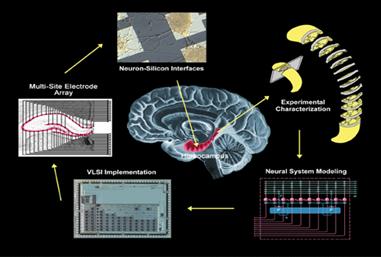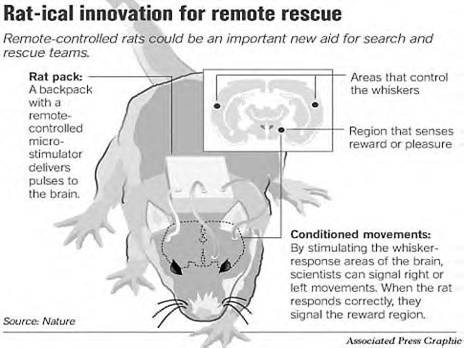





Published on Feb 14, 2025
Science has long been able to listen into the signals the brain sends, but is just now learning to turn those signals into meaningful action. The result is restoring movement and speech to the disabled.
One such effort is Cyberkinetic's BrainGate Neural Interface System, now undergoing clinical trials. The tiny chip was developed by Brown University's John Donoghue, who serves as Cyberkinetic's Chief Scientific Officer.
Brain chips are made with a view to enhance the memory of human beings, to help paralyzed patients, and are also intended to serve military purposes. It is likely that implantable computer chips acting as sensors, or actuators, may soon assist not only failing memory, but even bestow fluency in a new language, or enable "recognition" of previously unmet individuals. The progress already made in therapeutic devices, in prosthetics and in computer science indicates that it may well be feasible to develop direct interfaces between the brain and computers.
This technology is only under developmental phase, although many implants have already been made on the human brain for experimental purposes. Let's take a look at this developing technology
Researchers at the crossroads of medicine and electronics are developing implantable silicon neurons that one day could carry out the functions of a part of the brain that has been damaged by stroke, epilepsy or Alzheimer's disease.
The U.S. Food and Drug Administration have approved implantable neurostimulators and drug pumps for the treatment of chronic pain, spasticity and diabetes, according to a spokesman for Medtronic Inc. ( Minneapolis ). A sponsor of the Capri conference, Medtronic says it is already delivering benefits in neural engineering through its Activa therapy, which uses an implantable neurostimulator, commonly called a brain pacemaker, to treat symptoms of Parkinson's disease.
Surgeons implant a thin, insulated, coiled wire with four electrodes at the tip, and then thread an extension of that wire under the skin from the head, down the neck and into the upper chest. That wire is connected to the neurostimulator, a small, sealed patient-controlled device that produces electrical pulses to stimulate the brain.
These implants have helped patients suffering from Parkinson's disease to a large extent.

Fig-3: Computer chip model of neural function for implanted brain protheses
The famed mathematician Alan Turing predicted in 1950 that computers would match wits with humans by the end of the century. In the following decades, researchers in the new field of artificial intelligence worked hard to fulfill his prophecy, mostly following a top-down strategy: If we can just write enough code, they reasoned, we can simulate all the functions of the brain. The results have been dismal.
Rapid improvements in computer power have yielded nothing resembling a thinking machine that can write music or run a company, much less unlock the secrets of consciousness. Kwabena Boahen, a lead researcher at the University of Pennsylvania 's Neuroengineering Research Laboratory, is trying a different solution. Rather than imposing pseudo-smart software on a conventional silicon chip, he is studying the way human neurons are interconnected. Then he hopes to build electronic systems that re-create the results. In short, he is attempting to reverse-engineer the brain from the bottom up.

The first product from Boahen's lab is a retinomorphic chip, which he is now putting through a battery of simple vision tests. Containing nearly 6,000 photoreceptors and 4,000 synthetic nerve connections, the chip is about one-eighth the size of a human retina. Just as impressive, the chip consumes only 0.06 watt of power, making it roughly three times as efficient as the real thing. A general-purpose digital computer, in contrast, uses a million times more energy per computation as does the human brain. "Building neural prostheses requires us to match the efficiency, not just the performance, of the brain," says Boahen. A retinal chip could be mounted inside an eyeball in a year or two, he says, after engineers solve the remaining challenges of building an efficient human-chip interface and a compact power supply.
Scientists say they have developed a technology that enables a monkey to move a cursor on a computer screen simply by thinking about it.. Using high-tech brain scans, the researchers determined that small clump of cells.were active in the formation of the desire to carry out specific body movements. Armed with this knowledge, [researchers at the California Institute of Technology in Pasadena ] implanted sensitive electrodes in the posterior parietal cortex of a rhesus monkey trained to play a simple video game..
A computer program, hooked up to the implanted electrodes,.then moved a cursor on the computer screen in accordance with the monkey's desires - left or right, up or down, wherever "the electrical (brain) patterns tells us the monkey is planning to reach," according to [researcher Daniella ] Meeker . [ Dr. William Heetderks , director of the neural prosthesis program at the National Institute of Neurological Disorders and Stroke,] believes that the path to long-lasting implants in people would involve the recording of data from many electrodes.
The future may well involve the reality of science fiction's cyborg, persons who have developed some intimate and occasionally necessary relationship with a machine. It is likely that implantable computer chips acting as sensors, or actuators, may soon assist not only failing memory, but even bestow fluency in a new language, or enable "recognition" of previously unmet individuals. The progress already made in therapeutic devices, in prosthetics and in computer science indicates that it may well be feasible to develop direct interfaces between the brain and computers.
Computer scientists predict that within the next twenty years neural interfaces will be designed that will not only increase the dynamic range of senses, but will also enhance memory and enable "cyberthink" - invisible communication with others. This technology will facilitate consistent and constant access to information when and where it is needed.
The linkage of smaller, lighter, and more powerful computer systems with radio technologies will enable users to access information and communicate anywhere or anytime. Through miniaturization of components, systems have been generated that are wearable and nearly invisible, so that individuals, supported by a personal information structure, can move about and interact freely, as well as, through networking, share experiences with others. The wearable computer project envisions users accessing the Remembrance Agent of a large communally based data source.
As intelligence or sensory "amplifiers", the implantable chip will generate at least four benefits:
• It will increase the dynamic range of senses, enabling, for example, seeing IR, UV, and chemical spectra;
• It will enhance memory;
• It will enable "cyberthink" - invisible communication with others when making decisions, and
• It will enable consistent and constant access to information where and when it is needed.
For many these enhancements will produce major improvements in the quality of life, or their survivability, or their performance in a job. The first prototype devices for these improvements in human functioning should be available in five years, with the military prototypes starting within ten years, and information workers using prototypes within fifteen years; general adoption will take roughly twenty to thirty years. The brain chip will probably function as a prosthetic cortical implant. The user's visual cortex will receive stimulation from a computer based either on what a camera sees or based on an artificial "window" interface.
https://members.tripod.com
www.informationweek.com/story/IWK20020124S0026
www.bu.edu/wcp/Papers/Bioe/BioeMcGe.htm
www.mercola.com/2001/sep/12/silicon_chips.htm
| Are you interested in this topic.Then mail to us immediately to get the full report.
email :- contactv2@gmail.com |